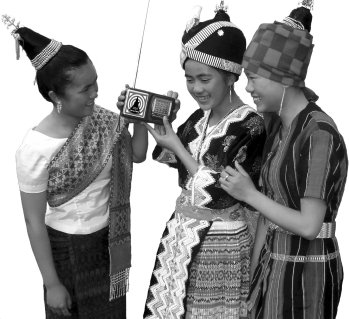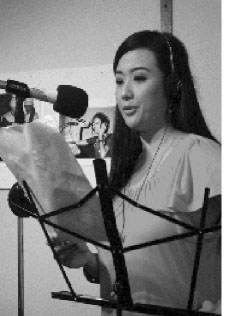“In the past I was frightened when I had to speak in front of a crowd. Now I speak with confidence and without fear, thanks to my involvement with Khoun Community Radio for Development. I am quite well-known now in Khoun District and people know and recognise my voice.”
That is what Somsanouk Phommahasay described as one of the positive experiences she encountered as a volunteer community radio broadcaster in Laos.
The results of the PC4D research informs us of the importance of traditional communications tools for intermediary groups to reach grassroots women. The statement of Samsanouk tells us that we can go beyond the use of traditional and new communications tools in reaching grassroots women.
From the recipient of information to the creator of information
If we say “information is power,” controlling information is even more powerful! The intermediary groups empower grassroots women by informing them about their rights. But the information still comes from an “outside” view. How about if the information is coming from the actual perspectives of community women?
What if women become the producers of their own news stories, as we say it in community radio?
In a survey conducted by AMARC-WIN Asia Pacific1 and Isis International among women community radio broadcasters in Asia Pacific from 2006 to 2007, most respondents described the experience of producing their own radio progamme as most empowering. Indartini of Balay Budaya Minomartani FM in Indonesia said, “I made a lot of new experiences and I can socialise with a lot of people from different backgrounds. I also gained knowledge about the diversity of culture, arts and traditional music.
Meanwhile, Ganga Devi Gurung of Solu FM in Nepal shared, “The women community broadcasters gained confidence to share their experiences, problems, thoughts, ideas etc.” Estrella F. Catarata of Central Visayas Farmers Development Center in the Philippines expressed: “ Through the radio work, I became broadminded and interested in studying and analyzing issues.”
It is obvious that these radio programmes produced by community women have another impact on the listeners in the community. Suddenly they can hear their voices over the airwaves. Women’s voices are hardly heard in main/malestream media, except in connection with crimes, disaster and tragedies or ridiculed in variety and game shows. The survey showed that hearing community voices discussing serious issues and voicing opinions on the radio has an empowering impact on the listeners too.
Ani S. of Suara Punakawan Radio in Indonesia explained, “Thanks to the radio broadcasts, house wives are no longer afraid to discuss things that were considered taboo before.”
Meanwhile, Deepak Koirala of Lumbini Radio in Nepal shared: “Kamala Bhandari a resident of the community encouraged widows over the radio to change the dress code and wear red instead of white sarees. “
For Yvonne Krauth, Cur tin FM, Australia: “The radio programme broke the loneliness of widowhood and old age.”
Finally, Eurica Pereira of Rakambia Community Radio in East Timor said the interest among community women to become radio volunteers has increased: “When we made an announcement calling for new volunteers a lot of women came, interested in producing programmes on health, education, women and children’s rights.”
Changing lenses – changing images of women
PC4D Phase II envisions the appropriation of new and traditional communication tools by grassroots women. Through capacity building, teaching women how to use communication tools such as radio, video, print and posters, blended with the use of new ICTs, primarily in audio and video editing and internet blogging, using FOSS2.
Phase II also includes grassroots women participation in analysing the way they have been portrayed in blogs on the internet. This might trigger the interest of the women to create their own images and stories on the internet and in other media. And hopefully will broaden their capacity to critically look at the portrayal of women in the media in general.
Not just a skills training
In the PC4D Phase II framework, capacity-building is not just about transferring skills to grassroots women, so that women can access communication tools. Skills always come with certain values, pre-determined by the patriarchal society.
Grassroots women have very little buying power, thus they are not the target audience to be served by main/malestream media.
We want to look at these values and how these skills are being used to misrepresent women or patronise women. Together, the training will develop empowering forms of using communication tools. Not just empowering those who apply the communication skills but also for the audiences.
Right to communication - a two way process
Article 19 of the Universal Declaration of Human Righs states “Everyone has the right ...to seek, receive and impart information ...”. Many efforts in the development industry focus on the right to seek and receive information, but are ignoring the fact that access to the major information outlets, such as media institutions, and the internet are becoming more and more globalised -- profit oriented, controlled and determined by a few.
Grassroots women have very little buying power, thus they are not the target audience to be served by main/ malestream media. PC4D Phase I confirmed that most grassroots women do not have access to internet due to the digital divide. A majority cannot access the information on the internet and much less impart information via the internet.
PC4D phase II focuses on the right to impart information. It concentrates on the communication tools most accessible to community women identified in PC4D I, such as community media.
No more representation but presentation
The findings of the blog analysis, trainings and fora will be shared with other grassroots women’s organisations primarily in popular forms such as publications and multi-media toolkits and interactive spaces.
The forum series hopes to create discussion among grassroots women on a development agenda tailored to their communication needs. It invites social movement actors and networks to a critical discussion of the PC4D model to further validate and refine it.
Endnotes:
1 World Association of Community Radio Broadcasters – Women’s International Network Asia Pacifc
2 Free and Open Source Software





 The
The 
 Isis Resource Center holds one of the largest feminist collections of materials in the Global South. With 40 years of publication experience, Isis holds a vast collection.
Isis Resource Center holds one of the largest feminist collections of materials in the Global South. With 40 years of publication experience, Isis holds a vast collection.